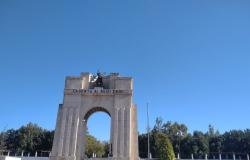The city of the rural young girl. The face of beautiful girl with a basket of fruit on his head is the heraldic emblem of Pomezia, founded on 25 April 1938 at the height of the Comprehensive Reclamation of the Pontine Marshes, as part of a project of the fascist regime to create new industrial, agricultural and housing centers around Rome. The heraldic coat of arms («Blue, with a golden border, on the bust of a young rural girl of complexion, dressed in green, with a red handkerchief on her head knotted at the nape of her neck, and a golden basket placed on her head full of ears of corn and of natural fruit») came granted by the Sovereign on 3 November, 21st anniversary of the Austrian armistice request in the Great War. It is no coincidence that the city had in fact been built byNational Fighters Opera like all the other Pontine-founded cities.
Pomezia therefore celebrates its 86th birthday today, and is preparing, at the beginning of next July, to host the
Its master plan had been approved between the end of 1937 and the beginning of 1938 and provided for the development of a modern and industrialized city, in the area of the Pontine marshes. This area had been reclaimed in the 1930s and the Pomezia project was part of a broader reclamation and colonization policy. The city was rigorously planned, following a regular grid of streets and a design modern urban planning, with large green areas and public spaces. The goal was to create an industrial and residential center capable of host factory workers which would be built later. Interestingly, they were among the first settlers to populate the city Trentino families moved to Bosnia during the Habsburg rule, some groups of Romagna arrived shortly afterwards.
The anniversary of the foundation of Pomezia is coming celebrated every year with a series of events, including official ceremonies, exhibitions, theatrical performances, concerts and cultural activities. This celebration represents an important moment to reflect on the history and development of the city and to appreciate the legacy left by the fascist period in its architecture and community identity.
The architectural and urban planning creations of the Pomezia company they are different. The 2PST group, made up of architects, is working on the Pometino project Concezio Petrucci And Mario Tufaroli Luciano together with the engineers Emanuele Filiberto Paolini And Riccardo Silenzi, former planners of the city of Aprilia.
Many buildings were constructed in the few months of peace between the founding and the devastations of warfollowing the architectural ideals of the time, trying to create a union between functionality, rationality and aesthetics typical of the regime. Then, Pomezia was severely damaged during the Second World War. During the war period, Pomezia was subjected to aerial bombings of the Allied forces and suffered serious damage. The city, located between the front and Rome, was used by the German army as its headquarters and armaments production centre. The airstrikes aimed to disrupt German troops’ supply lines and destroy military infrastructure. The industrial zones e the inhabited centers were hit indiscriminately. Following the Allied offensive in 1944, Pomezia was occupied. Much of the city had been destroyed and its inhabitants had been forced to flee or find refuge elsewhere. The reconstruction required a lot of time and effort on the part of the local authorities and the population, but in the end Pomezia returned to being a vital urban centre.
Between the most notable architecture of the citylisted on the site pomeziaetorvajanica.it, it is necessary to cite:
- The square, overlooked by the buildings of civil and religious power, has now been renamed Independence Square;
- The Municipal House or Town Halloverlooked by the Civic Tower (former water reservoir) destroyed during the Second World War and rebuilt keeping faith with the original project;
- The Church, consecrated to San Benedetto Abate, characterized by a monumental façade on which the sculptural work of Venanzo Crocetti stands out with the “Stories of San Benedetto”;
- The House of Fascio, which housed the administrative headquarters of the PNF;
- The building of Posts and Telegraphswhich was also fundamental in the architecture of the main building nucleus of the Pontine cities as it constituted the communication link between the new towns and the rest of Italy.
- The GIL building (Italian youth of the littorio), composed of the school, kindergarten and gym located behind the Municipal House.








